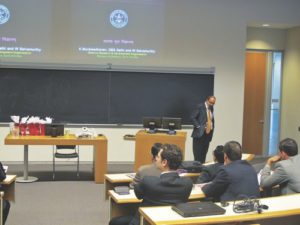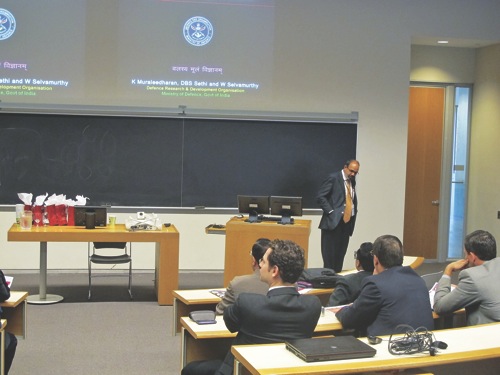Ernest Reid
Science & Technology Editor
Last week, York hosted the Canada-India Workshop on Frontiers in Science and Engineering.
 Leading Canadian and Indian researchers from government, academic, and industrial institutions were brought together for a two-day event hosted at Schulich. Researchers from York and Indian institutions signed agreements, confirming their mutual understanding and cooperation in research and development.
Leading Canadian and Indian researchers from government, academic, and industrial institutions were brought together for a two-day event hosted at Schulich. Researchers from York and Indian institutions signed agreements, confirming their mutual understanding and cooperation in research and development.
At the workshop, researchers from India and Canada also presented technical papers on space technology, health informatics, advanced material sciences, and applications to homeland security.
For M.K. Narayanan, governor of West Bengal, this workshop is “a significant step towards […] collaborative relations between India and Canada.”
“York University is well-positioned to provide a common forum for meaningful interaction between Canadian and Indian scientists/engineers,” he wrote in a public letter.
The event is a continuation of a symposium held in India early last year. York was welcomed by Indian research and development labs SAMEER and DRDO for a workshop on partnership and development between the two nations.
SAMEER stands for Society for Applied Microwave Electronics Engineering and Research, an R&D lab in Mumbai under India’s Department of Information Technology.
At the Frontiers conference at York last week, Dr. Alok Verma came from SAMEER to discuss the technical aspects of his research using infrared laser spectroscopy for homeland security.
His abstract explains that all known chemical warfare agents and explosive vapours have “strong optical absorption features” in the infrared region covering seven µm to 12 µm. Considering this fact, it’s worthwhile to investigate the use of optical spectroscopy for chemical weapon detection.
Dr. Verma says nerve agents VX and Sarin are the focus in the technology’s first phases of development.
Researchers from the DRDO also spoke at the symposium.
The DRDO stands for Defence Research and Development Organisation. The government agency primarily researches and develops defence technology for India’s military.
Director General and scientific advisor to the Indian Defence Minister Dr.V. K. Saraswat spoke at the opening ceremonies, along with the chief controller of R&D, Dr. Selvamurthy.
“I am glad to be a part of the Indo-Canadian initiative on sensor development[…]for environmental monitoring […] and development of [a early warning] system for chemical protection of closed environments,” Dr. Saraswat published in a statement.
The E-WARN system, Early Warning and Advanced Response, is a key focus of the York-India collaboration. Janusz Kozinski, dean of York’s Faculty of Science and Engineering, is heading the initiative.
The E-WARN system is designed for quickly detecting and responding to chemical attacks in closed spaces like malls, subways, or office buildings. An E-WARN system would save lives in the event like the Sarin release on the Tokyo subway in 1995. The faster one can detect chemical weapons, the faster facilities and evacuate and clean the affected area.
In March, the E-WARN response time was seven seconds. Researchers in India and Canada hope to decrease the response by 0.5 to 1.5 seconds.
On the second day of the symposium, DRDO researchers gave overviews of where the DRDO’s research is headed towards homeland security.
Dr. K. Muraleedharan, director of materials, discussed nanotechnology initiatives in defence research. He explained how nanotechnology will have huge impacts in energy security, food security, and national security. As well as applications in stealth and camouflage, nanoscience may also play a role in creating the fourth generation of nuclear weapons.
Associate director Dr. Beer Singh discussed recent advancements in chemical, biological, radiological and nuclear (CBRN) defence. The DRDO is developing systems to decontaminate chemical weapons like Sarin and sulphur mustard at the nano-level.
Dr. Singh also explained how Indian agencies can now achieve 100-per-cent decontamination of anthrax spores in six hours.
Due to its population density, Indian cities have to tailor their responses to CBRN attacks. Detection and containment strategies in the West might not be suitable. When dealing with CBRN attacks, scientists must consider all approaches.
“No detection system is foolproof,” Dr. Singh says.
In his open letter, Governor Narayanan is hopeful for continuing relations between Canada and India.
“Technological advancement has transformed the world into a global village, leading to free flow of ideas […] and knowledge,” he writes.
For Narayanan, a smaller world must translate into “meaningful interaction between societies, with the common objective of making the lives of individuals better and more secure.” Hopefully, the Canada-India symposium helped achieve that.
With files from Paulina Karwowska-Desaulniers


